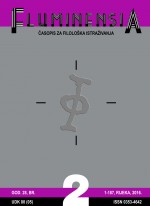ORTHODOX CHRISTIANS AS THE (CONFESSIONAL) OTHER IN KANIŽLIĆ’S CHURCH HISTORY AND THEOLOGICAL TREATISE KAMEN PRAVI SMUTNJE VELIKE [THE REAL STUMBLING-BLOCK OF THE GREAT DISCORD] (OSIJEK, 1780)
Keywords:
imagological analytical method, confessional (Catholic) identity vs. (Christian Orthodox) alterity, Antun Kanižlić, Croatian 18th-century controversial theology in national language, Orthodox Christians (Greeks and Slavs)Abstract
With the help of application of the imagological analytical method on Kanižlić’s controversial work Kamen pravi smutnje velike (Osijek, 1780) this paper deals with the constitution of confessional (Catholic) identity and (Orthodox) alterity. Given the importance of the socio-historical context in the imagological analysis, the paper takes into account not only the history of literature, but also the history of culture. The paper therefore aims to shed light on the confessional Otherness through the analysis of the interrelation of auto-images and hetero-images between the Catholic and the Orthodox Christians in the 18th century, primarily in Slavonia. The main purpose of this paper is to investigate the way in which religious identity is formed, in other words, to “(re)construct” the bipolarity of identity and alterity through the interrelation between auto-images and hetero-images. Alterity (Otherness) is, therefore, perceived as a constituent of and a complementary concept to the concept of identity and is also defined by its opposite and inferior character in relation to identity. (Hall 2006: 357–374) The specificity of the research topic in this paper are identity differences – two confessional identities (Catholic and Orthodox) in the same political area, primarily that of the Habsburg Monarchy. The paper also seeks to explain a different evaluation of the Orthodox Greeks (highly negative, seen as the main culprits that brought about the Schism) and the Orthodox Serbs (the Grenzers) in the Monarchy (ambivalent, but predominantly positive). On the basis of such a negative evaluation of Greeks, it can be concluded that there was an attempt in the Catholic polemics to portray the Orthodox Greeks, along with Ottomans, as dangerous religious enemies of the Catholics and Orthodox Christians (the Slavs) in the Monarchy. Laying the biggest blame on the Orthodox Greek renegades (who are arrogant, uncompromising and the main culprits who brought about the schism amongst Christian brothers) thus becomes a common procedure and probably a consciously chosen method in the Catholic religious polemics of the eighteenth century, whose main goal was to convince the Orthodox Christians to join the union.

